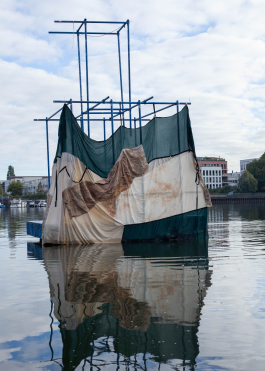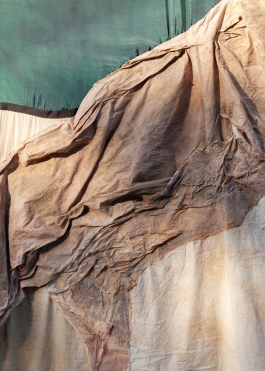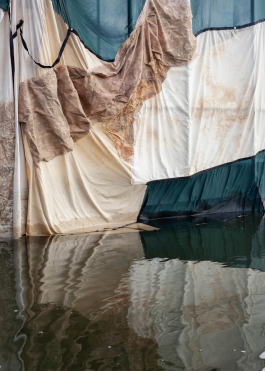
2023
Time is no river but a lake,
in which past, present and future flow into each other
The textile work Time is no river but a lake in which past, present and future flow into each other deals with transience and presence- as performative qualities that emerge from the transition from one material state to another. Materials were collected from the bottom of the river Spree for the installative work: Mud, lichen, bacteria, algae, rusty objects and plants found in the water have been applied to old fabrics over long periods of time in processes of repetition, fermentation and lingering, and sewn together with tension belts. The work reveals itself in its materialities and in the processes in which these have interacted and continue to interact with each other. The folds and discolorations in the fabric testify to the repetitive and durational way in which the textiles have been shaped over time. The boundaries between living and non-living matter, human and non-human involvement become fluid, allowing us to consider such boundaries, like a water surface, as moving matter itself.
Installation view, Spree-Channelsea, Insola Berlin
300 × 650cm; tension belts, latex, polyester, various fabrics dyed with mud,
lichen, bacterias, algaes, rusty objects and plants



Fotos: Carolin Seeliger

Installation view Time is no river but a lake, in which past, present and future flow into each other shown at Spree-Channelsea, Insola Berlin; 300 × 650cm; tension belts, latex, polyester, various fabrics dyed with mud, lichen, bacterias, algaes, rusty objects and plants
Time is no river but a lake in which past, present and future flow into each other, 2024
The textile work Time is no river but a lake in which past, present and future flow into each other deals with transience and presence- as performative qualities that emerge from the transition from one material state to another. Materials were collected from the bottom of the river Spree for the installative work: Mud, lichen, bacteria, algae, rusty objects and plants found in the water have been applied to old fabrics over long periods of time in processes of repetition, fermentation and lingering, and sewn together with tension belts. The work reveals itself in its materialities and in the processes in which these have interacted and continue to interact with each other. The folds and discolorations in the fabric testify to the repetitive and durational way in which the textiles have been shaped over time. The boundaries between living and non-living matter, human and non-human involvement become fluid, allowing us to consider such boundaries, like a water surface, as moving matter itself.


Photo: Caroline Seeliger